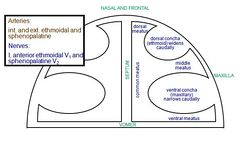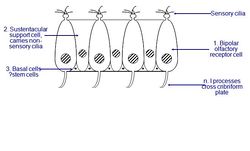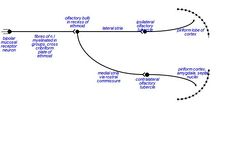Equine Nose - Horse Anatomy
Introduction
Olfaction is the sense of smell, which is the ability to perceive and distinguish odours. The sense of smell is well developed in horses, as they are prey animals.
The nose consists of the external nares with nasal cartilages, the nasal cavity (including the nasal meatus and conchae), and the paranasal sinuses. The borders of the nasal cavity are as follows:
Caudal: The cribrifrom plate of the ethmoid bone.
Ventral: Continuous with the nasopharynx.
Dorsal: The maxilla and the palatine processes of the incisive bones.
Rostrally, the median septum is a continuation of the ethmoid bone. The median septum is made up of hyaline cartilage, and divides the nasal cavity into left and right halves.
Nasal conchae
Nasal conchae are turbinate bones that project into the nasal cavity. Their purpose is to increase the respiratory surface area, and to create turbulence within the passing air. This helps to filtrate and warm or cool the air that passes through. They are cartilagenous or ossified scrolls that are covered with mucous membrane, under which is a layer of anastomosing blood vessels. There are dorsal and ventral conchae, the dorsal concha extending further into the nasal cavity. The conchae divide the nasal cavity into meatuses, which branch out from a common nasal meatus which is adjacent to the nasal septum. There are three nasal meatuses which branch from the common nasal meatus: dorsal, middle and ventral:
Dorsal nasal meatus: The passage between the roof of the nasal cavity and the dorsal nasal concha.
Middle nasal meatus: Between the dorsal and ventral conchae, and communicates with the paranasal sinuses.
Ventral nasal meatus: The main pathway for airflow leading to the pharynx, and is positioned between the ventral nasal concha and the floor of the nasal cavity.
Common nasal meatus: The longitudinal space on either side of the nasal septum.
The paranasal sinuses are extensions of the nasal cavity.
Vasculature
There is a dense network of blood vessels supplying the nasal mucosa. The sphenopalatine artery supplies the nasal cavity. The lateral and dorsal nasal arteries, which are branches of the facial artery, itself a branch of the external carotid artery, supply the nose. The infraorbital artery also supplies the nose.
Innervation
Sensory innervation is provided by the olfactory nerve (CN I).
Olfaction
The olfactory sensory neurones are present in the olfactory epithelium. It is the mucous membrane of the dorsal nasal conchae that is sensitive to smell. Here, odourants dissolve in the mucous membrane, and it is these odourants that are recognised by the olfactory sensory receptors. Sensory cilia, that are present on the surface of the olfactory receptors, project into the film of mucous. The mucous also contains antibodies, to prevent infection. This is because the olfactory neurones provide a direct passage, via the olfactory nerve (CN I), to the brain.
Central Olfactory Pathways
The olfactory receptors are embedded in the mucous membrane within the nasal cavity. They are bipolar neurones, and are covered with cilia (non-motile). It is thought that these cilia contain the active sites for the olfactory transduction process. The axons from the olfactory receptors join together and become the olfactory nerve (CN I). The axons pass through the perforations in the cribriform plate of the ethmoid bone, and enter the olfactory bulb. Once the axons have entered the olfactory bulb, the olfactory nerve synapses on mitral cells. The axons from these cells then project into the olfactory cortex of the cerebral hemispheres, via the olfactory tract. The olfactory cortex is the only region within the cerebral hemispheres that receives direct sensory input without any information first passing through the thalamus. This is because the olfactory system evolved before the thalamus.
Vomeronasal Organ
Click here for information on the Vomeronasal Organ.
Histology
Olfactory epithelium is made up of olfactory cells, sustentacular cells and basal cells. The olfactory axons and olfactory glands are present in the lamina propria. The first part of the nasal cavity, from the nostrils, is lined by keratinised stratified squamous epithelium. Sebaceous glands and hairs are also present in this region. The hairs function to keep dust out of the nasal cavity. The upper part of the nasal cavityis also lined by stratified squamous epithelium, but it is no longer keratinised. The epithelium then becomes pseudostratified columnar, and is ciliated. This is typical of the respiratory system, so this type of epithelium may also be known as respiratory epithelium. Goblet cells, which produce mucous, are present in this region of the nasal cavity. Mucous and serous glands are present in the connective tissue, the lamina propria, which lies underneath the epithelium that covers the nasal conchae. The olfactory region of the nasal cavity is formed by the membrane covering the dorsal nasal conchae. Cilia in this region are formed from olfactory cells, although they are non-motile. It is the membrane that covers these cilia that contains the olfactory receptors that are sensitive to smell, after the odours have been dissolved in the serous membrane covering the epithelium. The axons of these receptors bundle together within the lamina propria. The olfactory cells gain mechanical and metabolic support from the sustentacular cells.
Links
- Click here for more information on the nasal cavity
- Click here for more information on the paranasal sinuses
- Click here for more information on diseases of the nasal cavity and sinuses.


